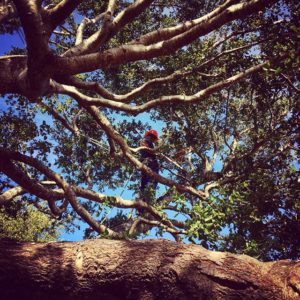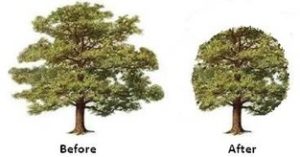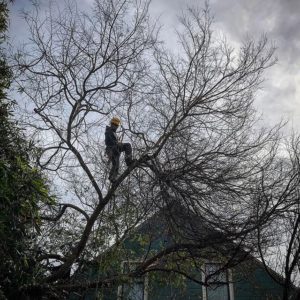Tree care and maintenance contribute to the health and safety of your trees, as well as the overall value of your property. With proper, routine care:
Trees Are Stronger
- Holistic tree care and maintenance improves the vitality of trees, helping them withstand stormy summers or persistent pests and diseases
- Preventative maintenance is critical to protecting trees from decline and protecting your property from potential damage
- With products such as Davey’s Arbor Green PRO® trees can obtain nutrients and overall vigor to promote healthy growth in an urban setting
Property Value Increases
- Keeping up on tree maintenance helps uphold and even enhance the value of your property and home
- Improving your tree’s natural form and appearance contributes to curb appeal
STRUCTURAL PRUNING
 Most trees benefit from regular structural pruning: the reduction of the density of a tree’s canopy to prevent wind damage and increase light levels. In this practice, the focus is on cutting unwanted branches back to their origin, leaving a strong, simplified network of branches that will have a chance to grow in a way that is most beneficial to the tree as a whole. This process will also help prevent a tree from splitting suddenly or being damaged in a storm.
Most trees benefit from regular structural pruning: the reduction of the density of a tree’s canopy to prevent wind damage and increase light levels. In this practice, the focus is on cutting unwanted branches back to their origin, leaving a strong, simplified network of branches that will have a chance to grow in a way that is most beneficial to the tree as a whole. This process will also help prevent a tree from splitting suddenly or being damaged in a storm.
Generally, structural pruning is preferable to crown reduction for maintaining the overall health and safety of a tree, though sometimes a fusion of these methods is utilized. Upon doing a risk assessment of a tree we can determine the best course of action.
REDUCTION PRUNING
 Reduction pruning is sometimes required when a tree that has grown too large for its surroundings, or has simply become unstable due to it’s size and situation. This is a common occurrence in urban settings. A tree may be growing into power lines or a neighbor’s building, or may pose a threat to an area frequented by pedestrians. When this happens, reduction pruning is used to scale back the weight, volume or height of the tree through removal of branches.
Reduction pruning is sometimes required when a tree that has grown too large for its surroundings, or has simply become unstable due to it’s size and situation. This is a common occurrence in urban settings. A tree may be growing into power lines or a neighbor’s building, or may pose a threat to an area frequented by pedestrians. When this happens, reduction pruning is used to scale back the weight, volume or height of the tree through removal of branches.
CROWN REDUCTION
 Crown reduction or “drop crotch-ing” is an advanced reduction pruning technique that should only be performed by a skilled arborist. In this process, cuts are made back to the node, bud or lateral stem which lower the size of the tree’s height and spread. If done properly, the tree can survive for happily.
Crown reduction or “drop crotch-ing” is an advanced reduction pruning technique that should only be performed by a skilled arborist. In this process, cuts are made back to the node, bud or lateral stem which lower the size of the tree’s height and spread. If done properly, the tree can survive for happily.
If done improperly, affected trees can develop poor crown geometry that can lead to instability, making the tree more susceptible to decay. Similar to topping, it can stimulate rapid epicormic growth in certain species, a setup for the development of poorly attached branches requiring frequent maintenance.
Crown reduction is often preferable to tree removal (and the prospect of having to wait years for a new tree to replace a privacy screen of foliage). Some species, such as Ficus Microcarpa, are more tolerant than others to this practice. Other trees, such as birch, respond very poorly to reduction cuts. Our professionally-training arborists, will asses your situation and advise accordingly.
VISTA PRUNING
 This type of pruning involves tailoring a tree’s foliage such that a view is restored while the tree’s health is kept in tact. Usually a tree that is pruned properly will enhance a view. It may require reducing the crown of a tree or thinning out the branches, creating spaces so you can see a view through a tree.
This type of pruning involves tailoring a tree’s foliage such that a view is restored while the tree’s health is kept in tact. Usually a tree that is pruned properly will enhance a view. It may require reducing the crown of a tree or thinning out the branches, creating spaces so you can see a view through a tree.
*Topping is a common, but drastic and unhealthy form of vista pruning, and in San Francisco, it is illegal to do to trees within 10 feet of the public right of way, which includes street trees. If you have street trees topped and the city deems them ‘maimed’ you could pay a fine of $1,600 per tree.
Hi, this is a comment.
To get started with moderating, editing, and deleting comments, please visit the Comments screen in the dashboard.
Commenter avatars come from Gravatar.